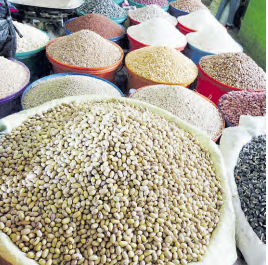
The prices of essential food items, particularly cereals and pulses, have been steadily declining since January.
Agriculture CS Andrew Karanja attributed the positive trend to improved crop production in 2023, which benefited from better distribution of subsidised fertilisers and favourable weather.
“Many households still have leftover stocks from last year’s harvest, which they are combining with this year’s yield in several counties,” Karanja said.
He spoke on the country’s food situation and the fertiliser subsidy programme.
Karanja said national food security is stable, with most households obtaining basic staples either from their own production or from local markets.
Maize is the most widely consumed staple, with an estimated annual requirement of 4.2 million tonnes for human consumption and livestock feed.
“Monthly usage is about 7.09 million bags, but there is a noticeable shift towards alternative staples like rice, root crops and tubers. The increased production of maize and other food crops in 2023 and the encouraging outlook for 2024 have improved household food security,” he said.
According to the Kenya National Bureau of Statistics, the Consumer Price Index dropped to 3.6 per cent in September 2024, down from 4.4 per cent in August, reflecting a continued decline in commodity prices.
Karanja said while the government has supported farmers with subsidised fertilisers, the growing season faced challenges due to flooding.
“Heavy rains during the long rains of 2024, linked to El Niño, affected 415,364 acres (168,092 hectares) of crops, valued at Sh111,715,431,” he said.
At the end of August, the estimated domestic stocks were: maize at 62.1 million 50kg bags, beans at 10.2 million bags, wheat at 9.3 million bags and rice at 2.9 million bags.
The October “Food and Nutrition Security Report” said these stocks are likely to improve as harvesting of the 2024 long rains crop progresses in North Rift counties.
“Overall, the country relies heavily on imports to meet its wheat consumption needs,” the report said.
The CS said for the long rains season, production is estimated at 75.97 million 50kg bags.
This estimate is based on farming more than 4,074,214 acres (1,648,776ha) with an average yield of 103 bags per acre.
Total maize production for the year will reach 94.41 million bags, based on a projected total area of 6,711,691 acres (2,716,125ha).
“Production of other food crops is also expected to improve compared to 2023, assuming the upcoming short rains season is stable,” Karanja said.
Dr David Gikungu, director of the Kenya Meteorological Services, said the onset of the short rains season is anticipated between the fourth week of October and the first week of November over some regions.
The October weather will impact agriculture and food security.
The expected above average rainfall in the highlands west of Rift Valley, Central and North Rift Valley is likely to provide sufficient soil moisture to sustain agricultural production.
“The rains may, however, adversely affect harvesting, drying and storage of grains,” he said.
According to the latest Integrated Food Security Phase Classification report, the cumulative seasonal benefits of the March to May 2024, long rains brought above-average rainfall across the country, particularly in arid and semi-arid lands counties.
This led to a significant improvement in food security compared to the same period last year.
From July to September 2024, around one million people, or five per cent of the ASAL counties’ population, are classified in IPC Acute Food Insecurity Phase 3, meaning crisis, or worse.
This includes about 895,000 people (5 per cent of the Asal population) in crisis phase and about 43,000 people (0.3 per cent of the Asal population) in IPC Phase 4, meaning emergency.
The IPC AFI scale is broken down
into five: minimal Phase 1, stressed
Phase 2, crisis Phase 3, emergency
Phase 4, catastrophe (household
classification) / famine (area classification) / famine likely Phase 5.








